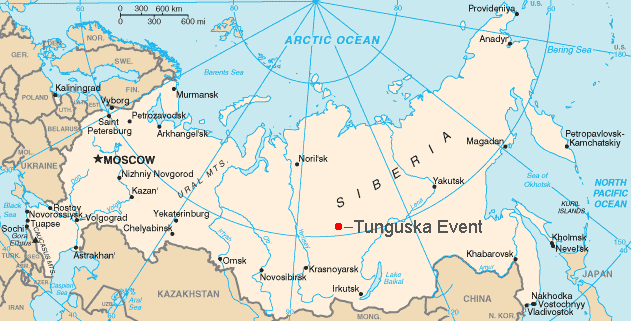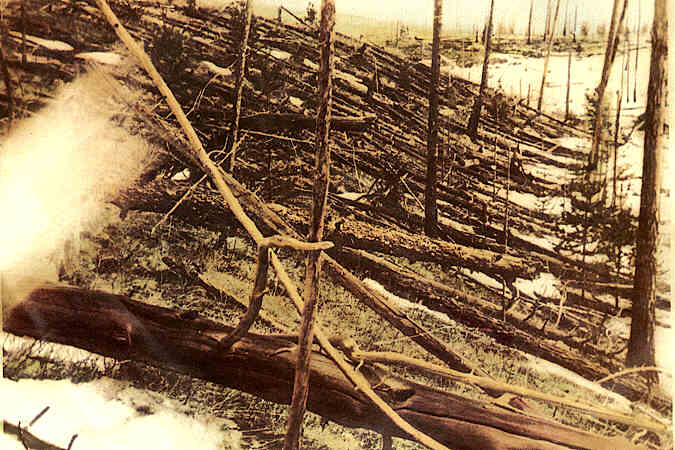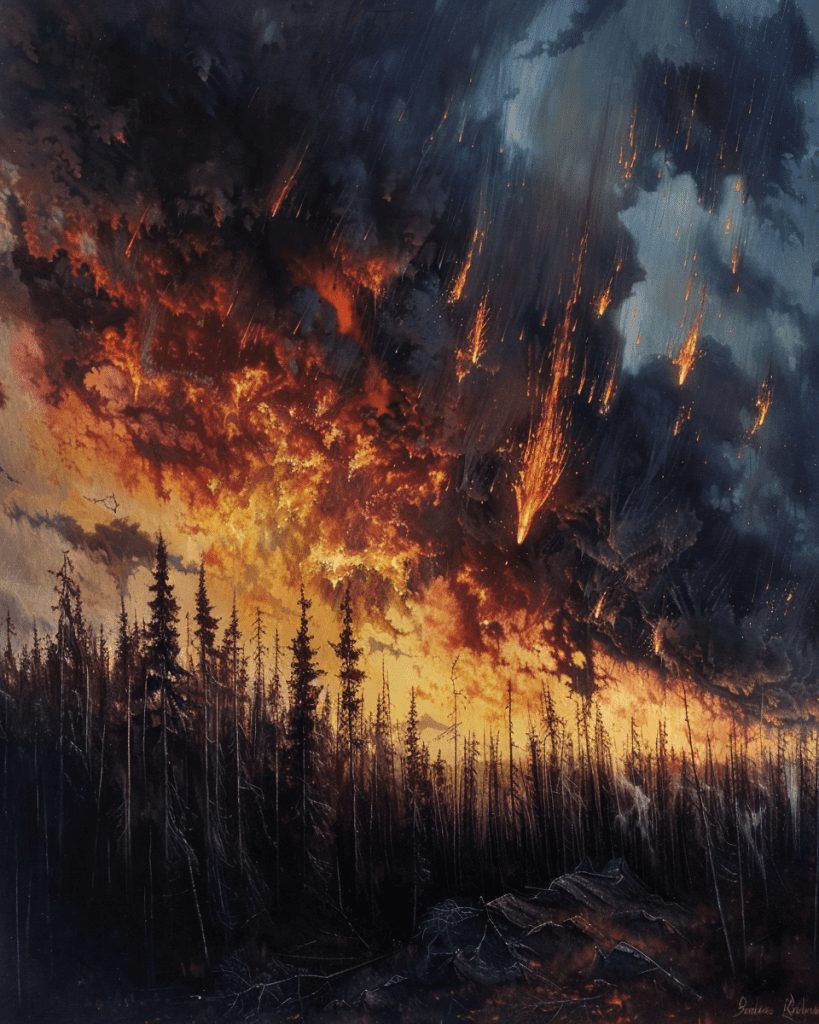Imagine you’re standing in the remote wilderness of Siberia on the morning of June 30, 1908.
Suddenly, the sky above you blazes with a fireball, and a tremendous explosion reverberates through the forest.
This event, known as the Tunguska event, remains one of the most powerful and mysterious occurrences in recent history.
The explosion, thought to be equivalent to 10-15 megatons of TNT, flattened an estimated 80 million trees across an area of more than 2,000 square kilometers.
You might wonder what caused such a cataclysmic event.
Scientists propose that the disaster resulted from an asteroid or comet entering Earth’s atmosphere and exploding before it struck the ground.
This aerial burst, in turn, unleashed an energy discharge powerful enough to knock down trees and incinerate everything in its vicinity.
Yet, despite extensive studies, the absence of an impact crater has led to various theories and debates.
The exact nature of the object and the specifics of the explosion are a puzzle that researchers have been piecing together for over a century.
The Event: What Happened in Tunguska?
In the early 20th century, a massive explosion rocked the remote Tunguska region of Siberia, without warning, altering the landscape and history as we know it.
Description of the Tunguska Region Pre-1908

The Tunguska region, located in what is now Krasnoyarsk Krai in Siberia, Russia, was predominantly a vast expanse of taiga—dense forests consisting mainly of conifers.
Before 1908, this isolated area was inhabited by indigenous Evenki people and a sparse number of Russian settlers, largely undisturbed by the wider world.
Account of the Day of the Explosion: Date, Time, and Eyewitness Reports
It was on the morning of June 30, 1908, that the peace of the Siberian taiga was shattered by an event that you could consider both spectacular and terrifying.
Accounts of the time indicated that the explosion occurred at approximately 7:14 AM, with varying eyewitness reports describing brilliant skies and catastrophic noise.
The phenomenon was so intense that it was felt hundreds of kilometers away, even causing windows to shatter and individuals to be knocked off their feet.
The Aftermath: Effects on the Landscape and Observable Changes
Shortly after the explosion, the landscape of Tunguska was irrevocably changed.
An area of around 2,000 square km was affected, with an estimated 80 million trees flattened in a radial pattern, a testament to the colossal force of the blast.
As the news of the event slowly reached the wider world, the intrigue and mystery surrounding it grew, fueled by the visible changes on the environment—charred flora and a transformed forest floor, which remained evident for many years afterward.

Historical Context and Early Explanations
This section sheds light on the understanding of natural phenomena at the time, the initial theories developed to explain the occurrence, and its portrayals in the media and scientific discussions of that era.
Early 20th-Century Understanding of Natural Phenomena
At the dawn of the 20th century, your understanding of cosmic events and their impact on Earth was fairly rudimentary.
Theories about space were abound, but the tools to fully comprehend and document extra-terrestrial events were limited.
When the Tunguska event took place, it challenged the existing knowledge and provoked a flurry of scientific curiosity.
Initial Hypotheses and Scientific Expeditions to the Site
The enigma that was the Tunguska event sparked numerous hypotheses.
One of the earliest theories suggested it was a volcanic eruption, though no volcano existed nearby. Another posited a massive coal dust explosion.
But it was the theory of a meteorite or comet impact, without the evidence of a crater, that held the imagination of many and prompted scientific expeditions to the remote taiga.
It would take more than a decade for the first such expedition to embark on its journey toward unraveling the mystery.
How the Event Was Reported in Contemporary News and Scientific Literature
Your contemporaries would have relied on newspapers and scientific journals to understand such an unprecedented event.
The news of the day relied on eyewitness accounts and the earliest scientific conjecture.
Reports varied, and at a time without social media or instant communication, the Tunguska event was a story as much steeped in myth as in fact.
Yet, contemporary scientific literature did take note of the event, with seismographs in western Europe recording the seismic waves it produced, giving credence to the event’s magnitude and fueling further investigation.
Theories and Scientific Investigations
In your quest to understand the Tunguska Event, you’ve likely come across a plethora of hypotheses and extensive studies. Let’s dive into the significant theories and scientific efforts that have aimed to solve this century-old enigma.
Overview of the Leading Theories About the Tunguska Event
You might wonder, what could cause such massive devastation without leaving a crater?
The leading theories include a cosmic impact from a meteoroid or comet, and more exotic explanations like a miniature black hole or antimatter collision.
However, more down-to-earth theories, like a natural gas explosion, also exist.
Meteoroid or Comet Airburst Theory
The most widely accepted theory is that a meteoroid or a piece of a comet entered the Earth’s atmosphere and exploded mid-air.
This airburst would have released energy equivalent to anywhere between 3 to 50 megatons of TNT, flattening trees and causing damage across a broad area.
Possibility of a Black Hole or Antimatter
Though less conventional, some have speculated that a black hole passing through Earth or an antimatter reaction might account for the event.
These suggestions, while intriguing, lack substantial evidence and are considered highly unlikely by the scientific community.
Geophysical Explanations Such as Gas Explosions
Some researchers have considered the possibility of a natural gas explosion from Earth’s crust as the culprit behind the Tunguska Event.
This terrestrial hypothesis suggests that geological activities might create such extreme conditions, albeit it remains a fringe theory.
Details of Key Scientific Investigations and Findings
Your investigation might lead you to wonder about the tangible evidence.
Despite the absence of an impact crater, expeditions later discovered microscopic silicate and magnetite spheres in the region’s soil – implicators of a cosmic event.
Leonid Kulik’s Expeditions in the 1920s and 1930s
Fascinating is the tale of Leonid Kulik, the first to lead an expedition to the Tunguska site.
His harrowing journeys in the 1920s and 1930s, though marred by inhospitable conditions, marked the beginning of serious Tunguska investigations.
Modern Satellite Imagery and Data Analysis
Advancements in technology have allowed scientists to scrutinize the Tunguska region with satellite imagery and data analysis.
These modern tools have helped to support the airburst theory and focus the search for answers on above-ground rather than terrestrial causes.
Impact on Popular Culture and Science Fiction
You’ve likely heard of the Tunguska Event, but you might not be aware of how deeply it’s woven into the fabric of both popular culture and the realm of science fiction.
It’s a tale that has captured imaginations and sparked mysteries that continue to echo through the various mediums of storytelling.
Examples of How the Tunguska Event Has Been Depicted in Literature and Film
The Tunguska Event’s enigmatic nature has made it fertile ground for storytellers.
In literature, it was imaginatively rendered as the result of alien intervention in Ed Earl Repp’s 1930 short story “The Second Missile”, framing the event as something more than a natural phenomenon.
The cinematic world isn’t untouched either; films have portrayed the event with a mix of awe and mystery, blending fact with fiction to engage and thrill audiences.
Influence on Conspiracy Theories and Extraterrestrial Hypotheses
It might tickle your fancy to learn that beyond the realms of stories, the Tunguska Event has also fueled numerous conspiracy theories and extraterrestrial hypotheses.
Some suggest it was an alien spacecraft rather than a meteor that caused the explosion. Whether you lend credence to these ideas or not, their presence in popular discussions reflects the Tunguska Event’s grip on our collective intrigue.
The Role of the Tunguska Event in Inspiring Scientific Curiosity
But it’s not all about wild theories and fictional portrayals.
Your understanding of the Tunguska Event becomes even more fascinating when you consider its impact on scientific curiosity.
This mysterious explosion from the past has prompted ongoing scientific inquiry, with researchers endeavoring to unravel the true cause behind the event.
Modern Scientific Consensus and Ongoing Research
In the quest to understand the Tunguska Event of 1908, scientists have wielded cutting-edge technology and relentless curiosity. Here’s how the consensus has crystallized and where the research is steering us next.
The Current Scientific Consensus on the Cause of the Tunguska Event
Today, most agree that a cosmic body, like a comet or asteroid, burst in the atmosphere above Siberia, releasing 10-20 Megatons of energy.
This modern interpretation stems from various studies, pointing towards an airburst higher than originally postulated.
Recent Studies and Technological Advancements in Research
Advances in computational tools have contributed significantly to the Tunguska research.
Researchers have conducted simulations with the information harvested from the Chelyabinsk meteor, enhancing our understanding of these celestial threats.
Such technological strides have refined the recurrence intervals of similar events, crucial for hazard assessment.
Final Thoughts
Investigations into events like Tunguska are not merely academic pursuits. They are crucial for preparing for future incidents, potentially safeguarding humanity.
As you’ve learned, each discovery, no matter how small, feeds into a greater understanding of the remarkable cosmos you call home.

